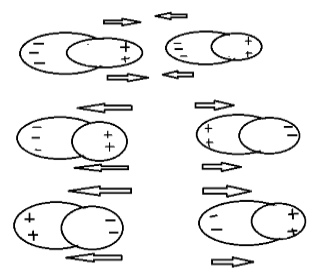Answer
395.7k+ views
Hint:Van der waals forces are specific intermolecular interactions observed generally in solids and liquids. They are electrostatic in nature. Van Der waals interaction arises from the interactions of positively and negatively charged species
Complete answer:
Intramolecular forces hold atoms within molecules together for example covalent or ionic bonds. But vander waal forces are the intermolecular forces that hold the molecules together. Vander waals forces include attraction and repulsion between atoms, molecules and surfaces. These forces help in determining physical properties like boiling point or melting point. London dispersion force, dipole-dipole interaction and hydrogen force are collectively known as vander waal force.

As we know, positive charges repel each other, negative charges also repel each other but positive charge and negative charge attract each other. As shown above.
In atoms, the electrons are continuously orbiting in shells. It is possible that at some point all the electrons come to one side of the atom, making it an instantaneous dipole that repels the electrons of neighboring atoms, making an induced dipole. This interaction between instantaneous dipole-induced dipole is known as the London dispersion force
Dipole-dipole forces are similar to London dispersion forces, but they occur in molecules that are permanently polar versus momentarily polar. . The ability of a molecule to become polar and displace its electron is known as polarisability. The more electrons a molecule contains, the higher its ability to become polar. when the molecules become polar the London dispersion forces and dipole-dipole interactions increase and hence vander waal forces increase between them.
Vander waal forces are maximum in ionic compounds. Vander waal forces also depend on the number of electrons present in the molecule, hence $AgBr$ have strong van der waal’s force.
Correct option is D.
Note:
Being the weakest of the chemical forces, they still support an integral structural load when many of these interactions are present. The main characteristics of vander waal forces are that they are weaker than normal covalent and ionic bonds. They are additives. They are short range forces hence when the distance increases these forces vanishes.
Complete answer:
Intramolecular forces hold atoms within molecules together for example covalent or ionic bonds. But vander waal forces are the intermolecular forces that hold the molecules together. Vander waals forces include attraction and repulsion between atoms, molecules and surfaces. These forces help in determining physical properties like boiling point or melting point. London dispersion force, dipole-dipole interaction and hydrogen force are collectively known as vander waal force.

As we know, positive charges repel each other, negative charges also repel each other but positive charge and negative charge attract each other. As shown above.
In atoms, the electrons are continuously orbiting in shells. It is possible that at some point all the electrons come to one side of the atom, making it an instantaneous dipole that repels the electrons of neighboring atoms, making an induced dipole. This interaction between instantaneous dipole-induced dipole is known as the London dispersion force
Dipole-dipole forces are similar to London dispersion forces, but they occur in molecules that are permanently polar versus momentarily polar. . The ability of a molecule to become polar and displace its electron is known as polarisability. The more electrons a molecule contains, the higher its ability to become polar. when the molecules become polar the London dispersion forces and dipole-dipole interactions increase and hence vander waal forces increase between them.
Vander waal forces are maximum in ionic compounds. Vander waal forces also depend on the number of electrons present in the molecule, hence $AgBr$ have strong van der waal’s force.
Correct option is D.
Note:
Being the weakest of the chemical forces, they still support an integral structural load when many of these interactions are present. The main characteristics of vander waal forces are that they are weaker than normal covalent and ionic bonds. They are additives. They are short range forces hence when the distance increases these forces vanishes.
Recently Updated Pages
In a flask the weight ratio of CH4g and SO2g at 298 class 11 chemistry CBSE

In a flask colourless N2O4 is in equilibrium with brown class 11 chemistry CBSE

In a first order reaction the concentration of the class 11 chemistry CBSE

In a first order reaction the concentration of the class 11 chemistry CBSE

In a fermentation tank molasses solution is mixed with class 11 chemistry CBSE

In a face centred cubic unit cell what is the volume class 11 chemistry CBSE

Trending doubts
Which are the Top 10 Largest Countries of the World?

Difference Between Plant Cell and Animal Cell

Give 10 examples for herbs , shrubs , climbers , creepers

Fill the blanks with the suitable prepositions 1 The class 9 english CBSE

Difference between Prokaryotic cell and Eukaryotic class 11 biology CBSE

Change the following sentences into negative and interrogative class 10 english CBSE

Write a letter to the principal requesting him to grant class 10 english CBSE

Name 10 Living and Non living things class 9 biology CBSE

Black foot disease is caused by the pollution of groundwater class 12 biology CBSE



